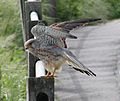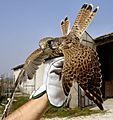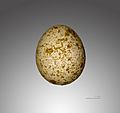Common kestrel facts for kids
Quick facts for kids Common kestrel |
|
|---|---|
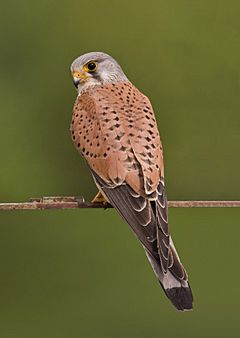 |
|
| Adult male Falco tinnunculus tinnunculus | |
| Conservation status | |
| Scientific classification | |
| Kingdom: | |
| Class: | |
| Subclass: | |
| Infraclass: | |
| Superorder: |
Neoaves
|
| Order: | |
| Family: | |
| Genus: | |
| Binomial name | |
| Falco tinnunculus Linnaeus, 1758
|
|
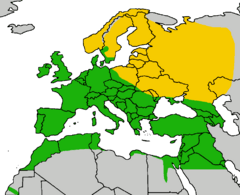 |
|
| Western part of range of F. t. tinnunculus (also occurs in Siberia farther east) Yellow = breeding only, green = all-year |
|
The common kestrel (Falco tinnunculus) is a bird of prey species belonging to the kestrel group of the falcon family Falconidae. It is also known as the 'European kestrel', 'Eurasian kestrel', or 'Old World kestrel'. In Britain, where no other brown falcon occurs, it is generally just called 'the kestrel'. The bird lives all over Europe, Asia, and Africa.
Description
Common kestrels are 32–39 cm (13–15 in) from head to tail. Their wings are 65–82 cm (26–32 in) when spread out. Females are larger. They are small compared with other birds of prey, but larger than most songbirds. Like the other Falco species, they have long wings and a long tail.
Their feathers are mainly light brown with black spots on the top and buff with narrow blackish streaks on the underside.
Food and feeding
When hunting, the common kestrel hovers about 10–20 m (c.30–70 ft) above the ground. common kestrels have very good eyesight. They can see small prey from a distance. Once they see the prey, the bird makes a short, steep dive. common kestrels eat nearly only mouse-sized mammals like voles. They also eat shrews and true mice. Small birds are also eaten, mostly in the summer when young birds are born. It also eats spiders and beetles when it finds them.
Images for kids
-
Female wintering in Kinnerasani Wildlife Sanctuary (Andhra Pradesh, India)
-
F. t. canariensis on Gran Canaria
See also
 In Spanish: Cernícalo vulgar para niños
In Spanish: Cernícalo vulgar para niños










